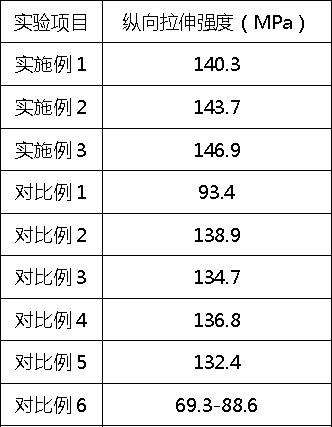Proton conduction diaphragm and preparation method thereof
A technology of proton conduction and diaphragm, applied in the direction of final product manufacturing, sustainable manufacturing/processing, fuel cells, etc., can solve problems such as short service life, failure to meet application requirements, poor toughness of proton conduction diaphragm, etc. Tensile strength, promotion of movement, and the effect of improving longitudinal tensile strength
- Summary
- Abstract
- Description
- Claims
- Application Information
AI Technical Summary
Problems solved by technology
Method used
Image
Examples
preparation example Construction
[0025] In an embodiment, the preparation method of the proton-conducting membrane comprises the following steps:
[0026] (1) Mix 230-280 parts by mass of boehmite ceramic powder, 8-17 parts of polymethyl methacrylate, 0.6-1.3 parts of ammonium polyacrylate, 0.5-0.8 parts of lauryl polyoxyethylene ether, 0.4 -0.7 parts of carboxyethyl cellulose, 1.3-2.2 parts of sodium bis(2-ethylhexyl) hydroxysuccinate sulfonate, 0.4-0.9 parts of disodium octadecyl succinic acid monoamide sulfonate, 2-3 parts After mixing 1 part of polyethyl methacrylate, 0.1-0.2 part of graphene, and 500-800 parts of water, stir for 15-20 minutes at a microwave power of 80-150W, a temperature of 40-50°C, and a speed of 200-300r / min , to obtain slurry;
[0027] (2) Coating the slurry prepared in step (1) on the surface of a polyolefin film with a thickness of 12-13 μm by micro gravure coating to prepare a semi-finished separator with a coating thickness of 0.8-2 μm;
[0028] (3) Take 60-75 parts by mass of ...
Embodiment 1
[0032] A method for preparing a proton-conducting membrane, comprising the steps of:
[0033] (1) 236 parts by mass of boehmite ceramic powder, 9 parts of polymethyl methacrylate, 0.7 parts of ammonium polyacrylate, 0.5 parts of lauryl polyoxyethylene ether, 0.4 parts of carboxyethyl cellulose, 1.5 parts Parts of sodium di(2-ethylhexyl) hydroxysuccinate sulfonate, 0.4 parts of disodium octadecyl succinic acid monoamide sulfonate, 2.1 parts of polyethyl methacrylate, 0.1 parts of graphene, 520 parts of water After mixing, stir for 19 minutes at a microwave power of 100W, a temperature of 42°C, and a rotation speed of 200r / min to obtain a slurry;
[0034] (2) Coating the slurry prepared in step (1) on the surface of a polyolefin film with a thickness of 12 μm by micro gravure coating to prepare a semi-finished separator with a coating thickness of 1 μm;
[0035] (3) Take 62 parts by mass of silane coupling agent kh550, add it to water, and add acetic acid to adjust the pH value...
Embodiment 2
[0038] A method for preparing a proton-conducting membrane, comprising the steps of:
[0039] (1) 275 parts by mass of boehmite ceramic powder, 16 parts of polymethyl methacrylate, 1.2 parts of ammonium polyacrylate, 0.7 parts of lauryl polyoxyethylene ether, 0.6 parts of carboxyethyl cellulose, 2 Parts of sodium bis(2-ethylhexyl) hydroxysuccinate sulfonate, 0.9 parts of disodium octadecyl succinic acid monoamide sulfonate, 3 parts of polyethyl methacrylate, 0.2 parts of graphene, 786 parts of water After mixing, stir for 16 minutes at a microwave power of 140W, a temperature of 48°C, and a rotation speed of 300r / min to obtain a slurry;
[0040] (2) Coating the slurry prepared in step (1) on the surface of a polyolefin film with a thickness of 12.8 μm by micro gravure coating to prepare a semi-finished separator with a coating thickness of 1.6 μm;
[0041](3) Take 72 parts by mass of silane coupling agent kh550, add it to water, and add acetic acid to adjust the pH value to 5...
PUM
| Property | Measurement | Unit |
|---|---|---|
| thickness | aaaaa | aaaaa |
| coating thickness | aaaaa | aaaaa |
| pore size | aaaaa | aaaaa |
Abstract
Description
Claims
Application Information
 Login to View More
Login to View More - R&D
- Intellectual Property
- Life Sciences
- Materials
- Tech Scout
- Unparalleled Data Quality
- Higher Quality Content
- 60% Fewer Hallucinations
Browse by: Latest US Patents, China's latest patents, Technical Efficacy Thesaurus, Application Domain, Technology Topic, Popular Technical Reports.
© 2025 PatSnap. All rights reserved.Legal|Privacy policy|Modern Slavery Act Transparency Statement|Sitemap|About US| Contact US: help@patsnap.com

